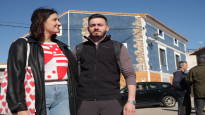AZUARA, SPAIN The small village of Azuara in northeastern Spain has only 600 inhabitants, but there are thousands of bodies, including Finns, in the mass graves around the village.
Three generations had time to silence the atrocities of the Spanish Civil War 1936–1939, but the young people of the village now want to find out what happened in the village.
They erected a monument to the Finnish volunteers at their battle sites on the slope of Mount Azuara.
19 years old Isabela Gorgas steps her boyfriend Erik Salvadorin27, along the path on the edge of the Azuara mountain to the top.
They lead the residents of the village to the Finns’ memorial service. The village erected a monument to the Finns, with the names of the Finns in the mass graves engraved on the slab.
Isabela’s parents live in Azuara. Isabela enjoys the village and visits home on weekends. The weeks are spent studying philosophy at the University of Zaragoza.
Alongside Isabela and Erik Daniel Morato and Eduardo Blasco climb the mountainside to the last battle positions of the Finnish machine gun company. They are active in the historical memory association of their home village.
– In my home village, after the war, there has been a tradition of silence for too long. It is the responsibility of our youth to break it and give a voice to those who were forced to remain silent about the atrocities of war due to fear.
– Finnish victims must be searched for and identified. They must be buried with honor. I respect them, because they fought for the village against fascism, adds Isabela Gorgas.
In the Spanish countryside, the hatred between the Reds and the Whites has been simmering since the war. The village, which remained in the power of the Francoists, has long been right-wing. Isabela, Erik, and the other youths break the fear-based deadlock as they honor the volunteers, who were leftists, anarchists, and communists.
– It is unbelievable that the Finns came from so far here in Azuara to defend us. It’s interesting. That’s why I’m interested in the entire Spanish Civil War, says Eduardo, 23.
21 Finns fought in the area
The fighting in the village of Azuara was short but decisive as part of the Battle of Aragon. The battle was partly decided by the end of the war by the general Francisco Franco to win. About the massacre at Azuara 85 years have passed (you switch to another service).
The 21 Finns who fought in the area were part of the Canadian Mackenzie-Papineau battalion. It fought against Franco’s army of 45,000 fighters, supported by Moroccan fascists.
There were 6,500 fighters in the Mackenzie-Papineau battalion, says research director Erik Salvador, who is familiar with volunteer fighters.
He studied to become a historian and teacher at the University of Zaragoza and leads research in Azuara.
A Finnish machine gun company protected the village from the top of the mountain. The women and children lived for months in a bomb shelter in the caves of the mountain. Men took care of the cattle, cultivated the land and fought wars.
Eight Finns were executed in Azuara
General Franco admired the Italian dictator Benito Mussolini and Germany Adolf Hitler fascism.
In addition to the Spanish, 70,000 Italians, 16,000 Germans and 80,000 Moroccans fought in Franco’s forces during the war. There were 7,000 in Franco’s forces who supported International Voluntary Fascism.
There were 50,000 volunteers from different countries on the side of the republicans, and 10,000 of them died in the battles.
The Finns fought on the side of the republicans. There were 250–400 of them in total, and a large number served as machine gunners. The Finnish volunteers came from Finland, the United States and Canada, and some also from Sweden.
They did not know Spanish, but a common language was found when those who came from Finland were placed in the Finnish battalion of Canada.
The Battle of the village of Azuara was short and took place in the plains and mountains of northeastern Spain in Aragon, south of the city of Zaragoza.
The spring winter of 1937 was cold in Azuara. It was -17 degrees below zero. The Finns placed their machine guns on the top of the mountain. In August, Franco’s forces captured the village.
The residents fled. The old residents of the village remember that the crackle of machine guns was the last sound they heard from the village when they fled.
A machine gun company of eight Finnish men was captured by the French troops in a motte on the mountain. They were executed.
Erik has an inkling of the Finns’ burial place, but no certainty about it.
– It is not human dignity to leave them in mass graves. We’re looking for them. We thus get detailed information about what happened to them. It is part of the history of my home village.
Ukrainian and Spanish volunteers have the same characteristics
Researcher of the Spanish Civil War, doctor of philosophy Mikko Ylikangas stands outside Madrid in the village of Brunete, surveying the front line where the Finns were fighting.
The fate of the Finnish volunteers was sad. A third of them fell and a large number were injured. One got sick and died in a French concentration camp. He is in a camp grave in the French Pyrenees.
Some returned to Finland, fought in the Winter and Continuation War, or defected to the Soviet Union, where they were executed.
Today’s Ukraine and Spanish volunteers during the civil war share the same characteristics, but the context of history was different compared to Ukraine.
In the Spanish Civil War, the rising fascism in Europe under World War II drove the Spanish to war against each other.
In Ukraine, volunteer fighters fought against Russia’s war of aggression in territories belonging to Ukraine.
